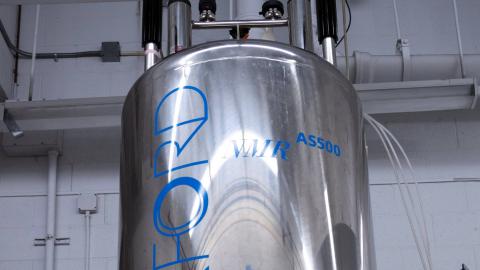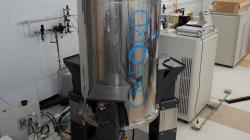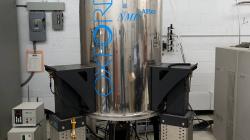500 MHz Nuclear Magnetic Resonance
Location and contact information
- Location: CCNY, Marshak 101
- Facility Manager: Dr. Padmanava Pradhan
- Phone: 212-650-8697/8266
Hours
- Open 24/7 to trained users
- Online calendar
User Fees
- Federal Users: $15.00/h
- Commercial Users: $22.00/h
All CCNY-affiliated PIs receive automatic subsidies in the amount of $7/h lowering the effective rate to $8.00/h
Frequent users of the facility may elect to take advantage of bulk rates* that are currently (Q1 FY2025) set as follows:
- Federal Users: $1,830/quarter
- Commercial Users: $2,750/quarter
All CCNY-affiliated PIs receive automatic subsidies in the amount of $884/quarter lowering the effective rate to $946/quarter
*Bulk rates require long terms commitments and may fluctuate based on overall user interest.
Facility Images
Background Information
The Varian (Agilent) Unity Invova-500 NMR (Nuclear Magnetic Resonance) spectrometer of the City College of the CUNY is located in the Plaza level of Marshak science building. The magnet has a field strength of 11.74 T (1H frequency of 500 MHz). This instrument performs a wide variety of multinuclear (1H, 13C, 31P, 11B and 15N) including 2D NMR experiments at variable temperature for structural identification of synthetic compounds. It is used extensively for elucidation of structure and stereochemistry of organic compounds and solution conformations of DNA adducts.
Primary Use
1H, 13C, 15N, 11B, other nuclei Solvent Suppression, 1D NOE, DEPT 1D with variable temperature (-60C to 100C) All normal and gradient selected 2D experiments including gCOSY, TOCSY, HSQC, gHMQC, HMBC, ROESY, NOESY etc. Equipment Specification 5mm PFG Switchable (Standard Probe) X/H Tunable to X nuclei from 31P (202 MHz) to 15N (50 MHz) Ideal for detection of broadband nuclei Used for most 2D experiments including COSY, TOCSY, HSQC, HMBC, ROESY, NOESY Variable Temperature (-60oC to 100oC)
Selected Publications
- M. K. Lakshman, A. Deb, R. R. Chamala, P. Pradhan, R. Pratap. Direct arylation of 6 phenylpurine and 6-arylpurine nucleosides by ruthenium-catalyzed C-H bond activation, Angewandte Chemie, International Edition 2011, 50, 11400-11404. DOI: 10.1002/anie.20110403
- R. Kumar, P. Pradhan and B. Zajc. Facile synthesis of 4-vinyl- and 4-fluorovinyl-1, 2, 3-triazoles via bifunctional “click-olefination” reagents. (2011) Chem. Commun. 47, 3891-3893.
- V.S. Balachandran, S. R. Jadhav, P. Pradhan, S. De Carlo and G. John. Adhesive Vesicles through Adaptive Response of a Biobased Surfactant. (2010). Angew. Chem. Int. Ed. 4, 9509.
- Synthesis of N6,N6-Dialkyladenine Nucleosides Using Hexaalkylphosphorus Triamides Produced in Situ. M. K. Lakshman A. Choudhury, S. Bae, E. Rochttis, P. Pradhan, A. Kumar (2009) Eur. J. Org. Chem. 152-159.
- Palladium-Catalyzed Synthesis of Nucleoside Adducts from Bay and Fjord Region Diol Epoxides. E. Champeil, P. Pradhan and M. K. Lakshman (2007) J. Org. Chem. 72(14) pp 5035 – 5045.
- Highly diastereoselective synthesis of nucleoside adducts from the carcinogenic benzo[a]pyrene diol epoxide and a computational analysis. M. K. Lakshman, J. C. Keeler, F. N. Ngassa, J. H. Hilmer, P. Pradhan, B. Zajc and K. A. Thomasson (2007) J. Am. Chem. Soc., 129, 68-76.
- Voltage gating and anions, especially phosphate: A model peptide. P. Pradhan, R. Ghose and M. E. Green (2005) Biochim. Biophys Acta. (2005) 1717, 97-103. •Synthesis and Reactions of 2-Chloro- and 2-Tosyloxy-2'-deoxyinosine Derivatives. N. Pottabathini, S. Bae, P. Pradhan, H. Hanh, H. Mah and M. Lakshman (2005), J. Org. Chem. 70(18); 7188-7195.
- Mild and Room Temperature C-C bond forming reactions of nucleoside C-6 arylsulphonates, M. K. Lakshman, P. Gunda and P. Pradhan. (2005) J. Org. Chem. 70 (25), 10329-10335
- Ghosh, A. K.; Zajc, B.: Fluorinated 1-Phenyl-1H-tetrazol-5-yl Sulfone Derivatives as General Reagents for Fluoroalkylidene Synthesis, J. Org. Chem. 2009, 74, 8531–8540.
- Zajc, B.; Kumar, R.: Synthesis of Fluoroolefins via Julia-Kocienski Olefination, Synthesis 2010, 42, 1822-1836.
Last Updated: 03/18/2025 16:17


